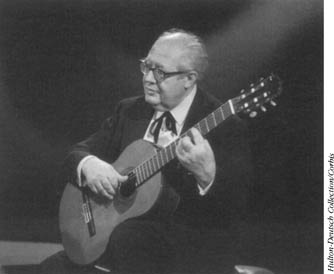ANDRÉS
SEGOVIA
Andrés Segovia was the most important and influential classical guitarist of the 20th century. He established the classical guitar as a serious concert instrument, transforming it from an amateur’s instrument to one respected in recital.
Segovia was born in the Andalusian town of Linares, Spain, on February 21, 1893. He took up the guitar despite the objections of his family, who wanted him to study the violin, and was largely self-taught. In 1912, he made his official debut at the Ateneo in Madrid. His debut in Paris in 1924 was attended by the composers Paul DUKAS and Manuel de FALLA. In 1928, Segovia made his United States debut at New York’s Town Hall, followed by a tour of Asia. Because of the Spanish Civil War, Segovia left Spain in 1936 and lived in Montevideo, Uruguay, and New York until returning home in the early 1950s.
While in the Americas, Segovia performed and taught extensively, inspiring many young guitarists to study the classical instrument and repertoire. His dedication to the guitar was all-consuming, and he performed regularly for 78 years until his death in Madrid, on June 2, 1987 at age 94.
Segovia recognised that the limited repertoire for the classical guitar was an obstacle to its being accepted as a serious concert instrument, so he expanded the repertoire by transcribing existing works and by commissioning new pieces. His transcriptions included Spanish vihuela (a plucked string instrument of the viol family), Renaissance and Baroque lute music, and the Spanish piano music of Isaac Albéniz and Enrique GRANADOS. He also expanded the repertoire by commissioning works from noted composers such as Heitor VILLA-LOBOS, Joaquín RODRIGO, Mario Castelnuovo-Tedesco, and Manuel Ponce.
Segovia advanced classical guitar by absorbing practices from 19th-century guitarists such as Fernando Sor and Francisco Tárrega, and combining them with his own idiosyncratic technique. His rich tonal palette, flexible pulse, and clear articulation were characteristic of what came to be known as the “Segovia sound.” He also worked with Albert Augustine and the Du Pont corporation to create the nylon guitar string, a major technical innovation which also contributed to the new guitar sound.

Pre-eminent Spanish classical guitarist Andrés Segovia transformed the repertoire and status of the instrument.
Through his legendary master classes, Segovia inspired many of the succeeding generation of classical guitarists, including John WILLIAMS. He was also a pioneer in recording. His first recording was made in 1927 and ultimately he made over 30 records which continue to form a springboard for later performers.
Jim Tosone
SEE ALSO:
CHAMBER MUSIC.
FURTHER READING
Segovia, Andrés. Andrés Segovia: An Autobiography of the Years 1893–1920 (New York: Macmillan, 1976);
Wade, Graham. Segovia: A Celebration of the Man and His Music (London: Allison & Busby, 1983).
SUGGESTED LISTENING
Bach, J. S.: Solo cello suites, arr. for guitar; Castelnuovo-Tedesco: Guitar Works; Ponce: Concierto del sur; Sonatas; Rodrigo: Fantasía para un Gentilhombre; Turina: Guitar works.